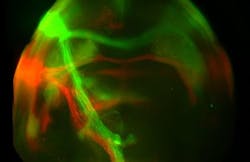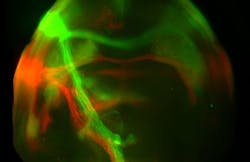Optogenetic stimulation could eliminate sweet cravings in brain's emotion center
A team of researchers at Columbia University (New York, NY) has shown in mice that the brain's cravings for sweet flavors, and its distaste for bitter flavors, can be erased by using optogenetic stimulation to manipulate neurons in the amygdala (the emotion center of the brain). The findings suggest that the brain's complex taste system, which produces an array of thoughts, memories, and emotions when tasting food, are discrete units that can be individually isolated, modified, or removed all together. The research points to new strategies for understanding and treating eating disorders, including obesity and anorexia nervosa.
Related: Optogenetics swaps out negative memories for positive ones in mice
"When our brain senses a taste it not only identifies its quality, it choreographs a wonderful symphony of neuronal signals that link that experience to its context, hedonic value, memories, emotions, and the other senses, to produce a coherent response," explains Charles S. Zuker, Ph.D., a principal investigator at Columbia's Mortimer B. Zuckerman Mind Brain Behavior Institute and the senior author of a paper that describes the findings.
The study builds upon earlier work by Zuker and his team to map the brain's taste system. Previously, the researchers revealed that when the tongue encounters one of the five tastes—sweet, bitter, salty, sour, or umami—specialized cells on the tongue send signals to specialized regions of the brain so as to identify the taste, and trigger the appropriate actions and behaviors.
To shed light on that experience, the scientists focused on sweet and bitter taste and the amygdala. Previous research by Zuker, a professor of biochemistry and molecular biophysics and of neuroscience and a Howard Hughes Medical Institute Investigator at Columbia University Irving Medical Center, and others showed that the amygdala connects directly to the taste cortex.
"Our earlier work revealed a clear divide between the sweet and bitter regions of the taste cortex," says Li Wang, Ph.D., a postdoctoral research scientist in the Zuker lab and the paper's first author. "This new study showed that same division continued all the way into the amygdala. This segregation between sweet and bitter regions in both the taste cortex and amygdala meant we could independently manipulate these brain regions and monitor any resulting changes in behavior."
The scientists performed several experiments in which the sweet or bitter connections to the amygdala were artificially switched on with light. When the sweet connections were turned on, the animals responded to water just as if it were sugar. And by manipulating the same types of connections, the researchers could even change the perceived quality of a taste, turning sweet into an aversive taste, or bitter into an attractive one. In contrast, when the researchers instead turned off the amygdala connections but left the taste cortex untouched, the mice could still recognize and distinguish sweet from bitter, but now lacked the basic emotional reactions, like preference for sugar or aversion to bitter.
Usually, the identity of a food and the pleasure one feels when eating it are intertwined. But the researchers showed that these components can be isolated from each other, and then manipulated separately. This suggests that the amygdala could be a promising area of focus when looking for strategies to treat eating disorders.
In the immediate future, Zuker and Wang are investigating additional brain regions that serve critical roles in the taste system. For example, the taste cortex also links directly to regions involved in motor actions, learning, and memory.
Full details of the work appear in the journal Nature.

